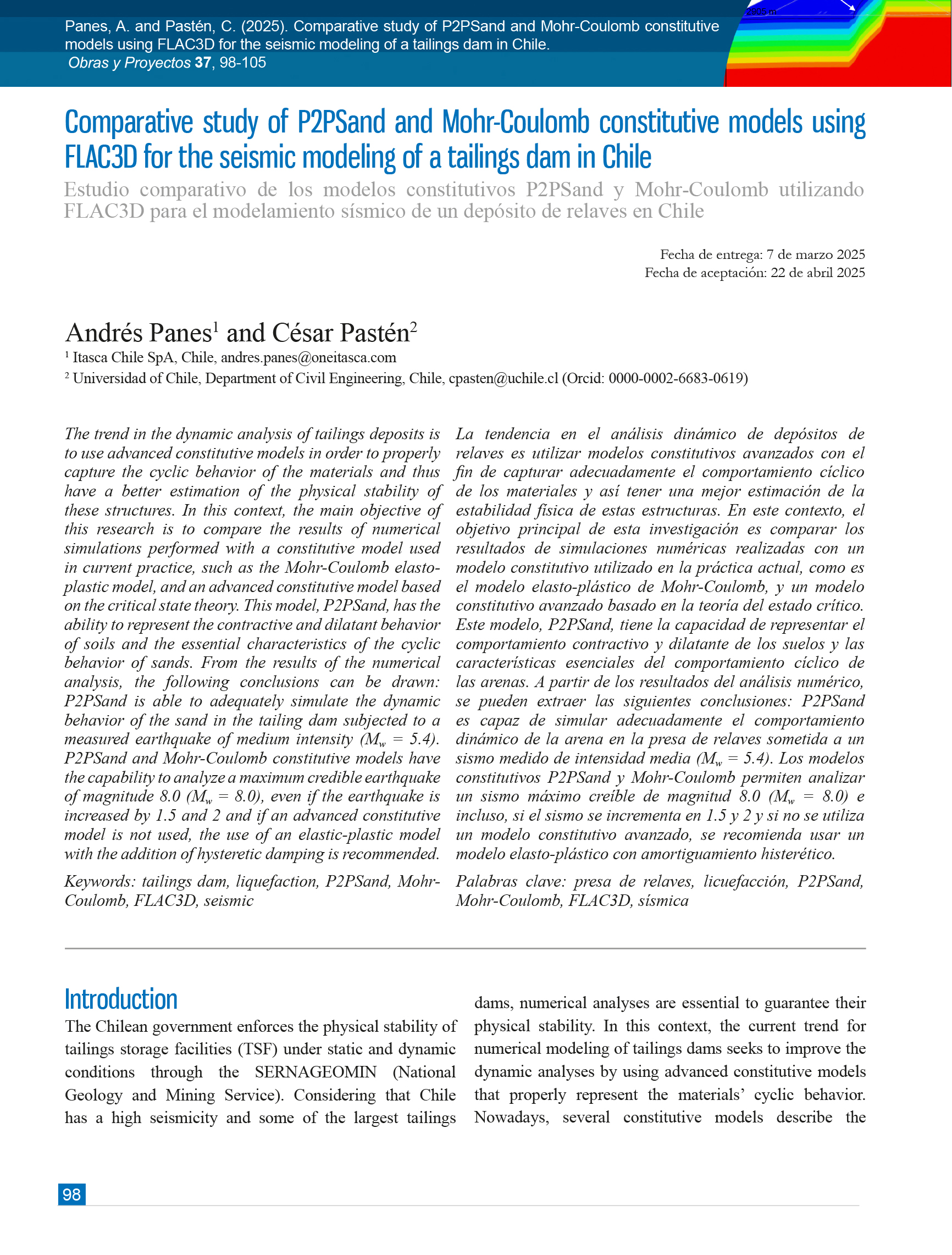Estudio comparativo de los modelos constitutivos P2PSand y Mohr-Coulomb utilizando FLAC3D para el modelamiento sísmico de un depósito de relaves en Chile
DOI:
https://doi.org/10.21703/0718-2813.2025.37.3241Palabras clave:
Presa de relaves, Licuefacción, P2PSand, Mohr-Coulomb, FLAC3, SísmicaResumen
La tendencia en el análisis dinámico de depósitos de relaves es utilizar modelos constitutivos avanzados con el fin de capturar adecuadamente el comportamiento cíclico de los materiales y así tener una mejor estimación de la estabilidad física de estas estructuras. En este contexto, el objetivo principal de esta investigación es comparar los resultados de simulaciones numéricas realizadas con un modelo constitutivo utilizado en la práctica actual, como es el modelo elasto-plástico de Mohr-Coulomb, y un modelo constitutivo avanzado basado en la teoría del estado crítico. Este modelo, P2PSand, tiene la capacidad de representar el comportamiento contractivo y dilatante de los suelos y las características esenciales del comportamiento cíclico de las arenas. A partir de los resultados del análisis numérico, se pueden extraer las siguientes conclusiones: P2PSand es capaz de simular adecuadamente el comportamiento dinámico de la arena en la presa de relaves sometida a un sismo medido de intensidad media (Mw = 5.4). Los modelos constitutivos P2PSand y Mohr-Coulomb permiten analizar un sismo máximo creíble de magnitud 8.0 (Mw = 8.0) e incluso, si el sismo se incrementa en 1.5 y 2 y si no se utiliza un modelo constitutivo avanzado, se recomienda usar un modelo elasto-plástico con amortiguamiento histerético.
Referencias
Beaty, M.H. and Byrne, P.M. (2011). UBCSAND constitutive model version 904aR. Itasca UDM web site.
Byrne, P.M. (1991). A cyclic shear-volume coupling and pore pressure model for sand. Second International Conference on Recent Advances in Geotechnical Earthquake Engineering and Soil Dynamics, St. Louis, Missouri, USA, paper 1.24, 47-55.
Cheng, Z. (2018). A practical 3D bounding surface plastic sand model for Geotechnical Earthquake Engineering Application. Conference on Geotechnical Earthquake Engineering and Soil Dynamics V: Numerical Modeling and Soil Structure Interaction. ASCE, S.J. Brandenberg and M.T. Manzari (eds.). Austin, Texas, USA, 34–47.
Cheng, Z. and Detournay, C. (2021). Formulation, validation and application of a practice-oriented two-surface plasticity sand model. Computers and Geotechnics 132, 103984.
Dafalias, Y.F. and Manzari, M.T. (2004). Simple plasticity sand model accounting for fabric change effects. Journal of Engineering Mechanics 130(6), 622-634.
FLAC3D (2019). Fast Lagrangian analysis of continua in 3 dimensions. Version 7.0. Itasca Consulting Group, Inc., USA.
Konno, K. and Ohmachi, T. (1998). Ground-motion characteristics estimated from spectral ratio between horizontal and vertical components of microtremor. Bulletin of the Seismological Society of America 88(1), 228–241.

Descargas
Publicado
Número
Sección
Licencia
Derechos de autor 2025 Universidad Católica de la Santísima Concepción

Esta obra está bajo una licencia internacional Creative Commons Atribución-NoComercial 4.0.







